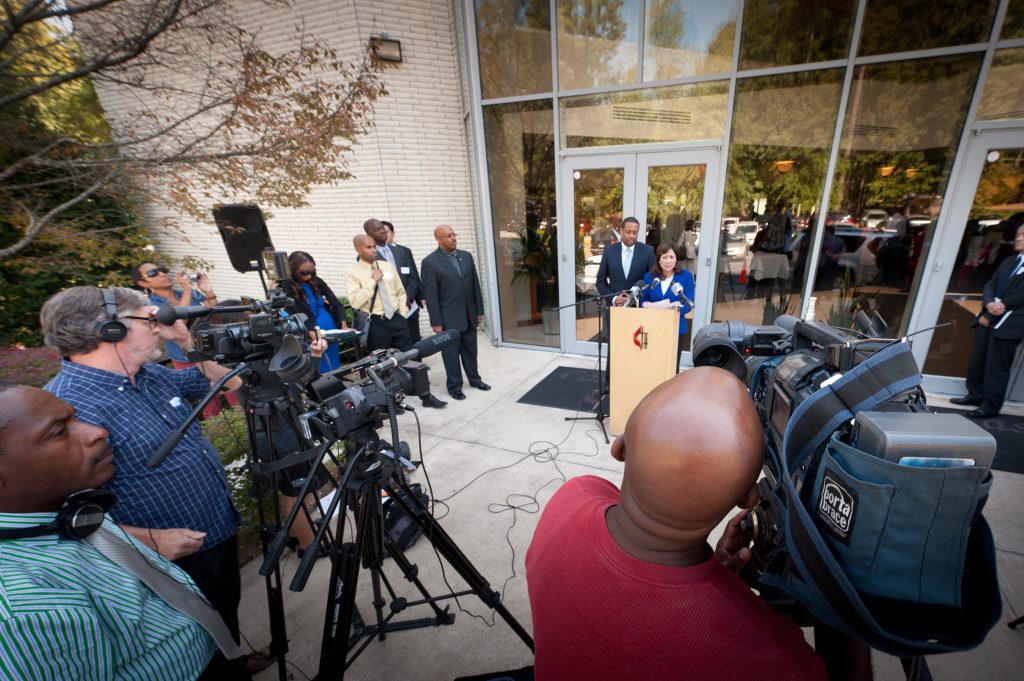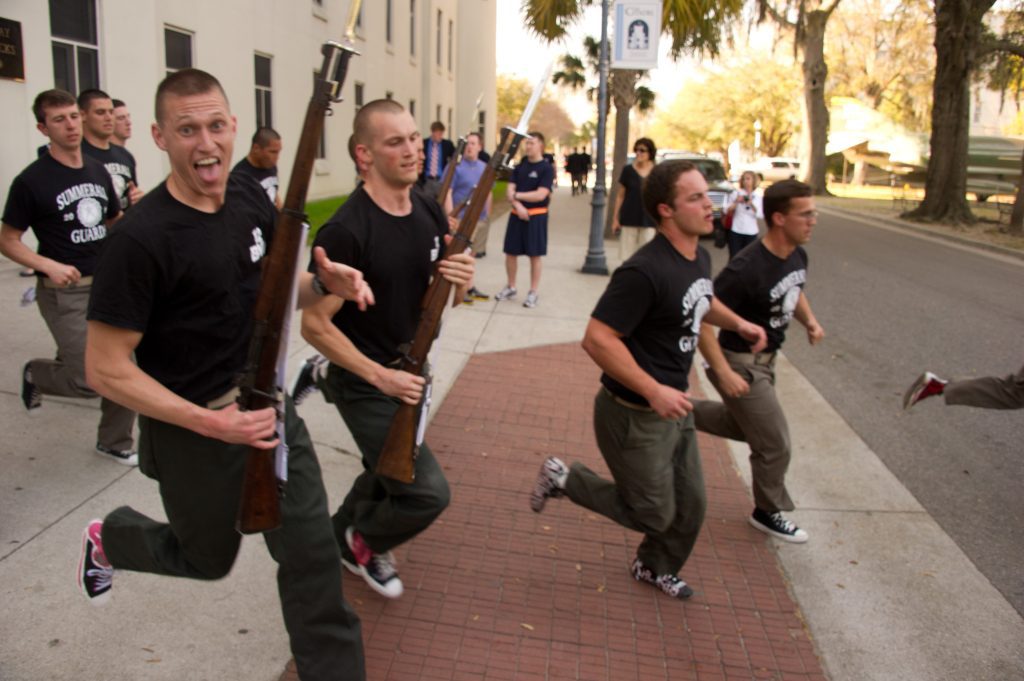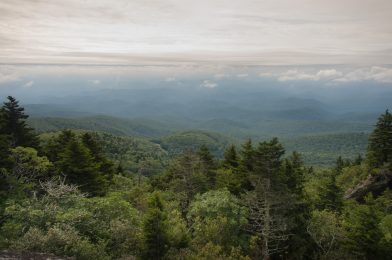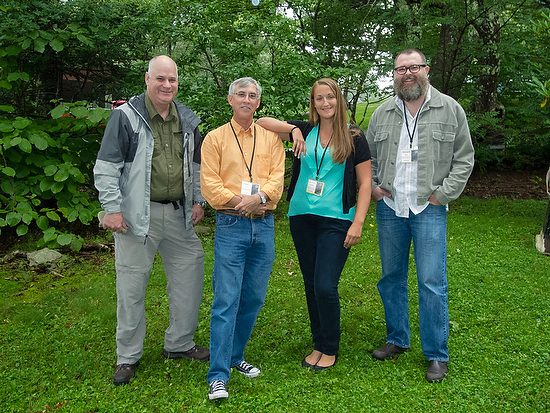| |
| Grandfather Mountain Camera Clinic 2013 faculty from left to right Stanley Leary, Chuck Burton, Lauren Carroll, and Roger May. |
Grandfather Mountain is North Carolina’s top scenic attraction
Initially organized in 1952 by Hugh Morton, the camera clinic invites photojournalists to Grandfather Mountain each August to discuss the nuts and bolts of good photography and relevant topics and trends in the field of photojournalism.
This year there were four presenters, Chuck Burton, Lauren Carroll, Roger May, and myself, on various topics.
 |
| Chuck Burton talks to the group about “Seeking The Different.” |
Seeking the Different
Chuck Burton started his talk with a couple of photos showing how difficult it is to find something unique. His first photo was a photo in Washington DC a few hours before Hillary Clinton was to address a congressional panel on the Benghazi Attack. The oversized desk with Secretary of State Hillary Clinton’s name was in the middle of the photo. In front of the desk were about 20 cameras on the floor, each one holding the place for a photographer.
Chuck then said in this situation, you create something unique.
Then he followed it up by showing a photo of all the remote cameras on the basketball game, and he didn’t have a place to put his. So Chuck then taped two AA batteries on the bottom of his camera to get a photo from the floor. The next photo is the excellent shot he got. Then he showed us the next game how there were now five cameras on the floor doing the same thing.
The point is that shooting every day as an Associated Press photographer; he is always “Seeking the Different” to keep the readers engaged. Photography isn’t about THE mountain top experience; it is about a lot more than that. You shoot a great photo, kick back, and collect the lottery winnings.
 |
| Roger May presents “The Importance of the Personal Project and Managing a Kickstarter Campaign.” |
Testify
Roger May’s North Carolina license plate is “DOCUMENT.” How appropriate for Roger. His Kickstarter project “Testify: A Visual Love Letter to Appalachia” is his journey to document his heritage in the mountains of West Virginia.
Roger helped us realize that the personal project is quite therapeutic, and after pouring your heart and soul into such a project, you would like to share it with the world. But unfortunately, many individual tasks don’t appeal to companies to publish because they don’t help promote their company directly. So, one of the best ways today to publish a book on your work is through crowdsourcing.
According to the Merriam-Webster Dictionary, crowdsourcing is the practice of obtaining needed services, ideas, or content by soliciting contributions from a large group of people, especially from an online community, rather than traditional employees or suppliers.
Kickstarter is a website that helps artists with crowdsourcing.
Community Newspapers
Lauren Carroll presented “Shine a Light Where There is None: The Importance of Community Newspapers.”
Lauren talked about how much she just enjoyed meeting people from the community, allowing her to shoot sports, features, and even news. While she doesn’t like putting a camera in people’s faces during tragedy, Lauren explains to her subjects how she wants to tell their story to the community.
 |
| On top of Grandfather Mountain, we are looking towards Charlotte, NC, from the mountain. |
Business practices
I spoke on “Making Money as an Independent Photographer.” I called it “Independent” and not “Freelance” because my friend Kenny Irby pointed out how maybe the word FREElancer communicates the wrong thing.
After the presentation, many folks said you know your talk would apply to every business. Since many in the audience were not full-time photographers and had other careers, they even commented how some of my points were helping them with some business decisions they needed to make.
The reality is that reading business books on starting a small business would apply to photography.
 |
| Coin operated binoculars at Grandfather Mountain with the “Swinging Bridge” in the background. |
Coin operated vision
Everyone invested in going to the top of Grandfather Mountain and hoping this would help their vision for the future. Instead, it helped to see the bigger picture from a different perspective.
Now that we have all been to the top of the mountain, we need to move forward, take what we learned, and let it help shape our direction.
 |
| The Singing Bridge is a mile high above sea level on Grandfather Mountain. |
Do you lack a sense of direction?
Maybe you need to put some quarters in a workshop to help you see your future more clearly. Find a workshop on something you would like to learn more about and take it.
Couple of ways to create your workshop. If you like someone’s work and don’t offer workshops, approach them and ask if you could pay them for a day of their time to teach you something they do. You never know. They may take you up on it.
I teach on a variety of topics around photography. If you are interested in a personal workshop or getting a few friends to split the costs, then call me. Here are some of the topics I teach, and if you think of something not listed here, contact me.
- Business practices for the photographer
- Hot shoe flash lighting
- Studio lighting
- Location Lighting
- Portraits
- Poising
- Product Lighting
- Missions Photography
- Humanitarian Photography
 |
| I loved playing King of the Mountain as a kid, so this is just me being a kid again on top of Grandfather Mountain. |
The More
Famous National Geographic Photographer William Allard gave a presentation at a conference I attended. Afterward, a young kid came up to Allard and said he needed this for inspiration.
William Allard turned to some friends and said you know we need one of these about every three months to keep all of us inspired. Remember, the workshops and seminars are there to inspire, but we must take this inspiration and do something with it.
When you leave a workshop, you need to have an action plan of what you will do differently than before the workshop.
Maybe after hearing Chuck Burton speak, you decide to try one new angle on a sporting event each time you shoot that you haven’t done before. You might take a few minutes and go into the stands to shoot or maybe spend more time shooting the bench rather than the action on the field.
After hearing Roger, May you decide to take on a personal project? You might even want to photograph your heritage like Roger.
Lauren Carroll challenged people to look for stories in their community rather than trying to plan a trip around the world.
Did the Mountain Top Experience do more than bring a tear and touch your heart? If so, we will see some activity in your life that shows the changes.










